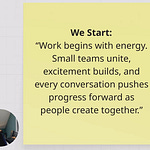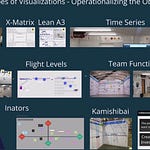Everyone's talking about flow…that magical state where work moves smoothly through your system and your team is made of productive energy. Flow can’t happen if you are experiencing drag…and every team does. You can't have flow without addressing drag.
You can visualize your work all day long, set up the prettiest Kanban board in the world, and limit your work-in-progress religiously. But if you haven't identified and tackled the hidden forces that slow, complicate, and muddy your work, you'll never achieve the flow you're chasing.
Where Drag Lives on Your Kanban
Drag isn't inefficiency. Drag isn’t just a bottleneck. Drag isn’t simply having too many task. Drag is the visible manifestation of deeper political, behavioral, and emotional forces. Drag shows up in every column of your board (which means we can deal with it).
In Your Backlog Drag is the Work People Won't Touch
Look at those tickets that have been sitting there forever. People aren't pulling them because they're uncomfortable with:
The complexity ("This looks like a career-ending task")
The political implications ("When I finish this, it goes to that leader I don't trust")
The vague definition ("I don't know what this actually means")
The perceived ownership ("I think this might be someone else's job")
The emotions behind it: Fear, confusion, avoidance, and the quiet hope that "maybe it'll just go away."
In Progress Drag is the Stuck and Struggling
In the active state, that point between starting and “finishing” (it gets even worse at finishing), we have tasks stalled for days or weeks. This isn’t because they are hard it’s because of:
Complex work given to one person (they're drowning alone, trying to fix something that needs collaboration)
Constant interruptions (they can't maintain focus or are being intentionally derailed)
Hidden overload (clean Kanban, messy calendar full of meetings)
Political hot potatoes (they're dragging their feet hoping priorities change)
The emotions behind it: Overwhelm, frustration, the internal dialogue of "I've been beating my head against this for five days and now I'm the jerk holding everyone up."
In Done Drag is the Lies We Tell Ourselves
We are so good at completing incomplete work. The Done Column is where teams don't expect to find drag, but it's often the biggest source. These are tasks moved to "Done" before they're actually complete because of:
Sprint or deadline pressure (we need to show progress)
Bureaucratic demands (compliance says it's done, reality disagrees)
FUD—fear, uncertainty, and doubt (better to call it done than admit we're stuck)
Lack of care or training (we don't know what "good" looks like)
The emotions behind it: Resignation ("I hate this task, I hate my job, I'm just moving this so people leave me alone"), desperation, and the dangerous comfort of "acceptable completion of unacceptable work."
From Drag to Flow and Finding a Path Forward
Flow is drag's positive opposite. Where drag creates stress, confusion, and stagnation, flow creates clarity, energy, and steady progress. You can see it on your Kanban when:
Tasks move steadily left to right
The board stays balanced—no columns pile up
Team members collaborate visibly across different steps
People celebrate progress as cards hit "Done" (and actually stay there)
The Transformation Process
To move from drag to flow, you need to:
Be Honest: Make all work visible, including the emotional and political dynamics around it
Plan Like a Professional: Set realistic limits, create psychological safety, and address the root causes of avoidance and fear
Create Real Team Focus: Align team priorities, establish clear definitions of "done," and build systems that prevent the behaviors that create drag
The Human Element
Remember: drag isn't just about process. It's about people living with bad process. Those stalled tickets and half-finished tasks represent real human experiences of fear, confusion, overwhelm, and resignation. The path to flow requires not just better visualization or stricter WIP limits, but creating an environment where people are (not feel, they actually need to be) safe to:
Ask for collaboration when the work requires it
(not ask for help, but acknowledge the work requires a team-lift)Find ways to learn together
(not ask for help when they don’t understand)See realistic and exciting work and act on it
(Not push back on unrealistic expectations)Finish work properly and professionally
(Not move it to done because of fear or sick mechanics).
Your Next Steps
If you're struggling to create flow despite having a good Kanban system, look deeper. What behaviors and emotions are creating drag in each column? What conversations aren't happening? What fears are driving people to avoid certain work or push things through before they're ready?
Flow isn't just smooth work movement. Flow is the visible result of clear systems, team trust, and a focus on doing the right work at the right time for the right reasons.
This post accompanies a deeper exploration of flow, drag, and the psychology of Kanban. If you're ready to move beyond surface-level process improvements and address the human dynamics that make or break your workflow, consider joining us for Personal Kanban Evolved where we workshop these exact problems with real teams doing real work.
Because if you're interested in flow, if you want a good working environment, you need to understand not just how work moves, but why it gets stuck and what to do about it.










